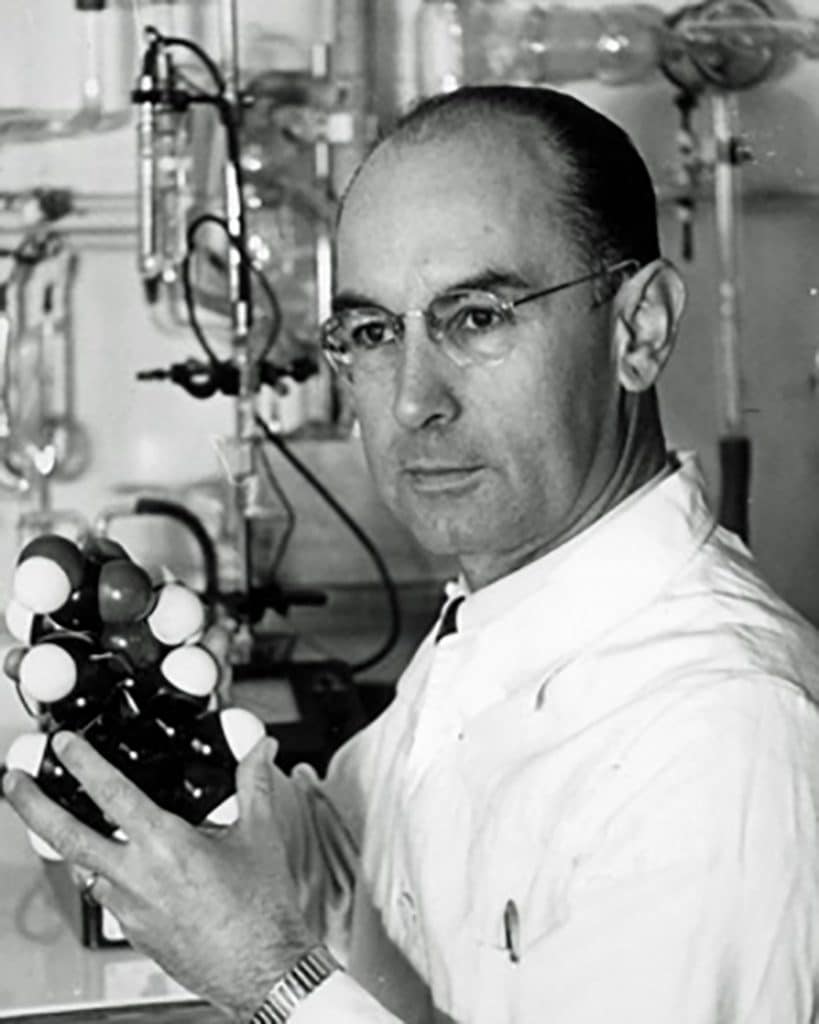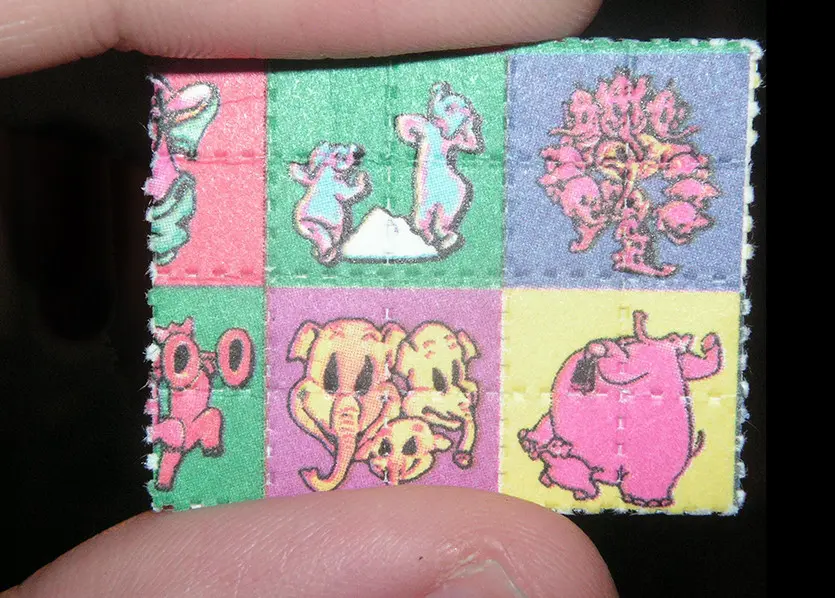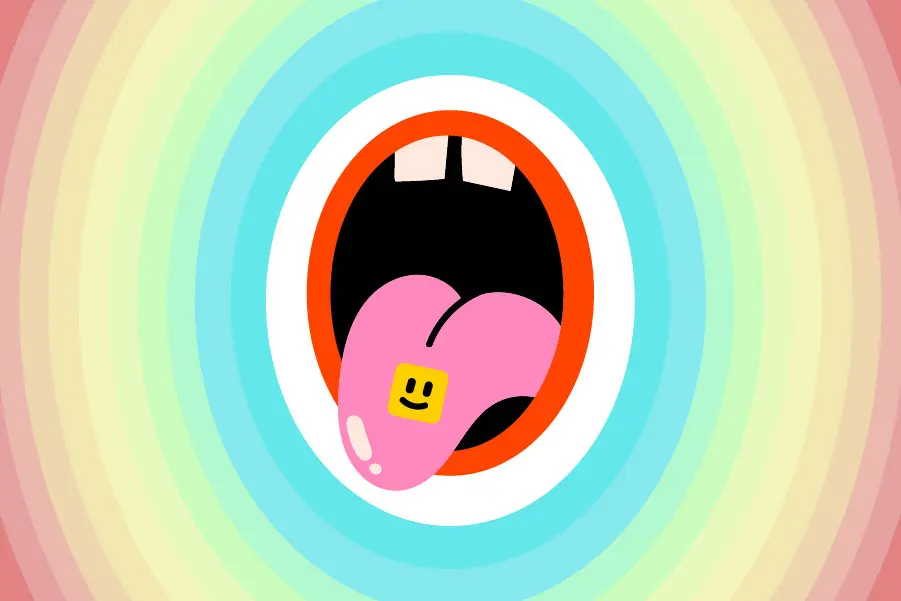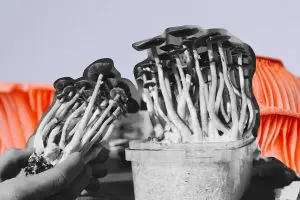“One day we’re at SST records and he says, you know, you should do LSD. And you know I’m not a drug type…It wouldn’t go well. And I said well golly, why should I take LSD? And he said, “cause you’re a real asshole.” – Henry Rollins, Black Flag
Is LSD Acid?
LSD, or lysergic acid diethylamide, is a favorite in the psychedelic family. In the words of poet and writer Mary Ruefle, the etymology of each word contains that word’s secret, and the word psychedelic is no different. The etymology of psychedelic traces its roots back to the ancient Greek words for psyche, or soul, and delous, or to make visible, to reveal.
This sort of revelation of the soul is addressed in the words of Timothy Leary—former Harvard psychologist and one of the cornerstone figures of the 1960s in LSD’s storied narrative: Psychedelics, inspired Leary, as he’s quoted saying “to think for yourself [and] question authority.” In his account of Leary’s legacy, Don Lattin, author of The Harvard Psychedelic Club, quoted the LSD evangelist’s prediction that “within one generation, we will have across the bay in Berkeley a Department of Psychedelic Studies. There will probably be a dean of LSD.” Indeed, there was truth to Leary’s prediction: This past year, UC Berkeley launched a new center for psychedelic science and education.
LSD is also called acid or Lucy—queue “Lucy in the Sky with Diamonds,” the song written by John Lennon and Paul McCartney, which made the “girl with the kaleidoscope eyes” famous. On the DEA’s website, other street names for LSD are listed as “blotter,” “dots,” “mellow yellow,” or “window pane.”
Read: Microdosing LSD: Could it Change Your Life For The Better?
With its effects discovered in the 1940s, LSD became an important part of the counterculture movement of the 1960s and has recently seen resurgence along with the mainstreaming of psychedelics in the present day. LSD has shown up in historical moments, such as in the music and scene of the Grateful Dead, “on the bus” throughout the course of Ken Kesey and the Merry Pranksters’ jaunt through North America (as documented in The Electric Kool-Aid Acid Test by Tom Wolfe), and betwixt the words and wonders of Hunter S. Thompson’s gonzo journalism.

And today, we’re seeing the Bay Area come alive with the electric vibrancy and ingenuity of acid in the Silicon Valley tech scene. In the words of Steve Jobs: “Taking LSD was a profound experience, one of the most important things in my life. LSD shows you that there’s another side to the coin, and you can’t remember it when it wears off, but you know it. It reinforced my sense of what was important creating great things instead of making money, putting things back into the stream of history and of human consciousness as much as I could.”
How to Grow Shrooms Bundle
Take Both of Our Courses and Save $90!
LSD can be used for self-introspection, as a tool of consciousness expansion, and it can also be used to have a really great time. But those with underlying mental health conditions, such as schizophrenia or risk of psychosis, should heed caution, work with a guide, or even avoid LSD—it is not for everyone.
What images are conjured when the collective culture thinks about acid? Melting walls? Cartoons on strips of paper? Driving away quickly from bats in a convertible in the desert? Healing from anxiety, addiction, or any host of psychological ailments?
Acid has tie-dyed not only the days of the Sixties, but also our present day culture and arts. A$AP Rocky, who raps about acid in multiple songs, has said that LSD “helps me cope with life…I’ve been doing this stuff since I got into the industry. People are scared to talk about it.” Chance the Rapper also professes his affection for LSD in the lyrics of his song “Acid Rain”: “Kicked off my shoes, tripped acid in the rain.” It would be stating the obvious to say that acid is a favorite psychedelic at live music events, at campouts, in the woods, and in many a refrigerator of friends, just waiting for that perfect moment.
Simply said, acid is a cornerstone of the psychedelic movement—and has been a game changer in people’s individual lives. One in 10 people in the United States (in other words, 10 percent of the American population) have reported using LSD at least once over the course of their lives. And according to a recent paper published in the journal Drug and Alcohol Dependence, LSD use in American adults increased by 56 percent between 2015 and 2018.
What is Acid? What is LSD?
LSD is a drug belonging to the lysergamide class. It is produced in a laboratory, from precursors that are found in nature (specifically, ergotamine, derived from ergot fungus). Also known as acid, LSD is a psychedelic that became popular in the 1960s counterculture, thanks specifically to a group of researchers at Harvard, including Timothy Leary and Richard Alpert (a.k.a. Ram Dass)—but more on that later. The cultural impact of LSD is vast, ranging from exerting great influence on musical groups like the Grateful Dead and the Beatles, to inspiring tech pioneers like Steve Jobs. LSD was also used in therapy before it became illegal, with doctors supervising their patients’ trips. One pertinent account of LSD’s healing potential can be found in the book Shivitti: A Vision, which recounts the story of a Holocaust survivor who underwent LSD therapy in Holland.
LSD Molecule

The way acid interacts with the brain is not fully understood from a biochemical standpoint.
LSD interacts with the brain by mimicking serotonin and binding to a number of its receptors. In doing so, there are cascading effects that influence other neurotransmitter systems, having effects on cognitive function and motor behavior.
This therefore results in the perceptual shifts that LSD is known for.
Lysergic Acid Diethylamide: History
So you want to take a deep dive into the backstory of LSD?
First, meet Albert Hofmann, a mid-20th century Swiss chemist and researcher with the pharmaceutical company Sandoz. He was working with derivatives of compounds found in ergot, a fungus that grows on rye and grains, when he first synthesized LSD in 1936.
Read: How LSD Is Made
“I had planned the synthesis of this compound with the intention of obtaining a circulatory and respiratory stimulant,” he said. “The new substance, however, aroused no special interest in our pharmacologists and physicians; testing was therefore discontinued.”
But a few years later, Hoffmann decided to take another look at LSD, so he synthesized a new batch. As he began to finish the process of recreating the mysterious chemical, he began to feel strange, so he put aside his work for the day and went home, sinking “into a not unpleasant intoxicated-like condition, characterized by an extremely stimulated imagination,” he later described it in his 1980 memoir LSD—My Problem Child. Convinced that the way he felt that day had to do with the acid, he decided to take LSD, this time intentionally, on April 19, 1943, now celebrated as Bicycle Day.
The effect that LSD had on Hofmann was profound.

“LSD spoke to me,” Hofmann told The New York Times in 2006. “He came to me and said, ‘You must find me.’ He told me, ‘Don’t give me to the pharmacologist, he won’t find anything.’” Indeed, Hofmann is quoted as calling LSD “medicine for the soul.”
During the 1950s and 1960s, Sandoz continued to evaluate LSD for therapeutic purposes and called it Delysid. Between 1950 and 1965, 40,000 patients were treated with Delysid tablets. The patients included people with schizophrenia, people working through OCD, and people with autism. It wasn’t until the Sixties that recreational use took off. Two of the main figures of this movement were Timothy Leary and Richard Alpert (who later became known as Baba Ram Dass). In 1960, Leary and Alpert began to explore the effects of psychotropic substances on the human mind while working as psychologists at Harvard. Eventually, they were expelled from academia because of these studies (which included giving acid to undergrads), but at that point the cat was already out of the bag, so to speak: Leary ventured out west, professing to the counterculture from upstate New York to San Francisco, and during the 1969 Summer of Love, to “turn on, tune in, and drop out.” Meanwhile Ram Dass, having come up and come down countless times on acid, trekked to India looking for a more consistent form of enlightenment.
In 1968, President Nixon named drugs the “public enemy number one,” which led to categorizing LSD as a Schedule 1 drug.
The CIA is actually credited with bringing LSD to The United States.
In the early 1950s, CIA chemist Sidney Gottlieb arranged for the Agency to buy the world’s entire supply of LSD. This was part of MK-ULTRA, the CIA’s initiative to find a means of mind control, which you can read more about here. The CIA paid $240,000 for all that acid, and once in the United States, they began spreading it around to hospitals, clinics, prisons and other institutions, asking them to carry out research projects to find out more about LSD.
Both beatnik poet Allen Ginsberg and writer Ken Kesey, Merry Prankster ringleader and author of One Flew Over the Cuckoo’s Nest, and Allen Ginsburg received LSD from Sidney Gottlieb.
LSD Trip
An LSD trip can be a magical, but also a challenging experience.
In the words of Hunter S. Thompson, “‘intensity’ is a fair word for it.” As he recommends, and as many a psychonaut will tell you, start low and go slow—and be sure that you’re in the right set and setting. “Try half a cube at first, just sit in the living room and turn on the music—after the kids have gone to bed,” Thompson said. “But never take it in uncomfortable or socially tense situations. And don’t have anybody around whom you don’t like.”
You may experience visual geometry or other changes in perception, images, or color, and music may be given new meaning.
Albert Hofmann, who first synthesized LSD in 1936, is quoted as calling LSD “medicine for the soul.”
According to brain imaging research from Imperial College London, patients under the influence of LSD exhibit a great deal of activity in the visual cortex, an effect which in turn seems to interrupt connections between other brain networks, leading to that “ephemeral state of oneness reported by users.”
How Long Does LSD last?
An LSD trip can last for eight to twelve hours. But this experience can differ from person to person and depend on the dose consumed.
While tripping on acid, time can become distorted and the LSD adventurer can feel as if time has been dragging on forever.
Effects of Acid
Acid can carry you through different phases of a trip: One minute may feel dark and confrontational, and the next you may be laughing so hard that you suddenly develop abs.
How to Grow Shrooms Bundle
Take Both of Our Courses and Save $90!
You may experience increased heart rate and body temperature, sensory distortion, hallucinations, euphoria, altered perception of the self and one’s surroundings, which may include visions or hallucinations, and in extreme cases, there can be negative effects such as psychosis or depression—which, in some cases, can also take place once the effects of the drug have worn off. In this case, it is important to seek professional medical care.
They may also be confronted with collapsing timelines or an overwhelming experience that everything is connected. The possibilities are endless.
Try not to label these moments of difficulty as a “bad trip.” To survive a challenging psychedelic experience, experts recommend: breathing, focusing on acceptance, leaning on friends that may be around, looking for distractions, or experiencing a change of scenery to navigate the waters of the trip.
Acid can have powerful long-term effects as well. LSD has been known to shift people’s perceptions, processes, and ways of being in the world.
In an interview with Amanda Fielding, founder of psychedelic think tank the Beckley Foundation, and referred to as both the Hidden Hand and the Countess of Psychedelics, she tells DoubleBlind the potent powers that LSD can lend to this shift:
“It’s basically because it makes the brain more neuroplastic, it can change its setting. It becomes like hot metal. It can reset itself. If the person is entering the situation with a positive wish to transform themselves from a negative setting such as depression, addiction, or trauma, and they’re in a safe setting with a good sitter and therapist who takes care of them., they can get the optimized potential of somehow shaking themselves free of that setting which has been there since they were young children and resetting the psyche and the body in a way which is more beneficial for their happiness. I found it very exciting that after this separation of science and spirituality, which has happened over the last hundreds of years, suddenly and slowly we’re finding at the center of this new science of psychedelics, at the very center of its healing potential, is the mystical experience.”
The “mystical experience” occurs when the ego dissolves and “the sense of self is unified with the whole, whether it’s the whole brain, or the whole outside world,” she explains. “It becomes unified with nature, or whoever you express it—sense, nature, God, the universe, it’s a sense of unity. That is a very healing situation, and there’s been wonderful research carried out by Johns Hopkins and NYU with people who are suffering from existential fear and depression due to being given a terminal sentence [cancer].”
LSD Benefits
LSD has been noted for its benefits and use in psychedelic therapy. LSD is physiologically nontoxic. You also cannot overdose from LSD.
Some studies are pointing to LSD being good for inflammation and physical ailments.
In a “Microdosing Research Programme” at Maastricht University in the Netherlands and the Beckley Foundation in the UK, scientists discovered that small doses of LSD increased pain tolerance in participants by 20 percent.
LSD has also been found to aid in anxiety relief. Study participants report increased perceptiveness, levels of insight, intimacy, happiness, and openness. For some, this is a long term restructuring of attitude and behavior.
On the surface, it’s difficult to pinpoint the long term effects of LSD because so much of the available information comes from anecdotal accounts or flawed studies. There is enough information out there, however, to draw some preliminary conclusions.
From its unintentional inception in the 1940s up to its criminalization in the late 1960s, LSD was used by many psychiatrists and researchers to treat alcohol addiction, as well as anxiety and depression related to advanced stage cancer. Early success encouraged researchers and advocates, but draconian laws stemming from the War on Drugs quickly dampered the initial signs that LSD and other psychedelics could be such a positive life-altering force for so many people.
Even as psychedelics are welcomed back into the scientific setting, there are still barriers that keep LSD on the backburner. For starters, the LSD trip is much longer than your typical mushroom trip, taking up to 12 hours instead of four to six hours. And not only is it expensive to spend more time in the laboratory setting, it’s also more energy-intensive on the subject and researchers. Therefore, if it’s possible to achieve similar results with psilocybin, say many researchers heading the new renaissance in psychedelic science, it’s difficult to make a sound argument in favor of researching LSD instead.
Even so, some of the most seasoned experts in the field still favor LSD over other psychedelics for the clarity it bestows upon those who take it. As Fielding put it, “I actually prefer LSD because it’s cleaner and purer…extraordinarily pure.” And, she adds, “incredibly small amounts of LSD can have a great effect, [which] is rather amazing. So it’s not really changing you, it’s enhancing you in the sense that you’re more yourself when you take it.”
Both LSD and psilocybin, Fielding notes, engender what’s called the “afterglow,” where people score higher than those on a placebo in the categories of mindfulness, openness, and optimism.
And when examining the positive long term effects of LSD, there’s another avenue to explore that has grown quite popular as the average person looks for ways to integrate psychedelics into their waking life: the microdose.
Are There Negative Long-Term Effects of LSD Use?
Through anecdotal and limited peer-review studies, it appears that LSD and other psychedelics present a bevy of positive effects for people, especially those suffering from certain mental conditions or struggling to cope with terminal illness.
But there are potential negative effects that can arise from long-term use of LSD as well. Fielding notes that it can increase suicidal notes among certain categories of people. Or if an individual has severe mental illness, acid may make it more difficult for them to generally function in the world or handle stressful situations, explains Charles Grob, professor of psychiatry at the UCLA School of Medicine. And those in this demographic, he adds, may be more prone to taking higher doses or doing acid more frequently.
“The concern for an individual who might take LSD on a fairly frequent basis is just increasing difficulty integrating the experiences, as well as connections with the outside world becoming problematic, such as it being harder to relate to others, who are not part of a frequent use psychedelic scene,” Grob says. “You’re more likely to have positive experiences and experiences you can work into your own processing over time, whereas if you’re doing it every week, two or three times a week, I think your general functioning in the world is going to decline, or there’s a concern that that’s the case. Though maybe not across the board, maybe if you’re an artist and it facilitates the production of your art, that can be an exception. But if you have a normal 9 to 5 job, then it’s awfully hard to set a desk and concentrate on a task that’s not that interesting when you’ve had these astonishing altered states of consciousness that have grabbed your attention and since you’re using it frequently, it’s still part of your sensorium.” People need an opportunity to come down and feel grounded, he adds. “ I don’t ascribe to the notion that LSD will drive you crazy persay, but I’ll say under certain conditions vulnerable people adverse set and setting, frequent use, high dosage, all bets are off.”
LSD Dosage
LSD is normally created as a tartrate salt, which has no color nor odor, and is water-soluble. Most commonly, LSD comes in the form of blotter paper (a perforated sheet of paper infused with LSD), or as a singular tab from said sheet. In other cases, some people may simply take liquid acid from a dropper, or place the liquid onto a sugar cube.
LSD is active at doses of 15 micrograms or higher. An average dose of LSD is 75 to 150 micrograms, while a tab may commonly contain about 100 micrograms.
- Threshold – 15 µg
- Light – 25 – 75 µg
- Common – 75 – 150 µg
- Strong – 150 – 300 µg
- Heavy – 300 µg +
In one study that took place over the course of a month, researchers administered various dosages of LSD to 20 healthy young adults. The findings suggested that doses of 13 and 26 micrograms are ideal for microdosing LSD.
LSD Tolerance
It’s possible to build up a tolerance to LSD. Saying it plainly, the more acid you drop the less you’ll experience its effects. Tolerance to LSD many other psychedelics builds almost immediately after consumption and lasts for up to two weeks after a single dose; tolerance to acid doesn’t require frequent use to come about.
Sheet of Acid

A sheet of acid is a sheet of blotter paper that is sometimes printed with designs, or perforated so that they can be cut or torn into small tabs (7mm is a typical size). Each sheet can contain 100+ doses.
Acid Tabs
A tab of acid is one of the squares on the blotter paper that is cut or torn off the larger sheet of acid.
Liquid Acid
You can also occasionally find acid as a liquid in a small jar, or on sugar cubes or altoids.
LSD is a non-addictive psychedelic, and currently illegal substance with lots of room left for study as psychedelics gain more mainstream attention.
The intense impact that LSD has had on the psychonauts who taught LSD’s lessons, don’t go unheard currently in psychedelic spaces. If LSD may be right for you, as with all things, do your research, phone a friend, be safe, and go with your gut.
LSD Facts
If you’re still looking for more info on LSD, check out these fun facts.
1. LSD played a role in the discovery of the serotonin neurotransmitter system. In 1954, after serotonin was first discovered in the brain, a team of researchers recognized the structural relationship between LSD and serotonin. They then proposed that some of the effects of LSD might be caused by its interference with the actions of serotonin in the brain.
2. A piece of advice for your psychedelic trip from Amanda Feilding on enhancing concentration while tripping: “ Out of the whole basic understanding I picked up in the Sixties, in 1966 to be exact, there were really two basic practical bits of advice. One was to take vitamin C when you take a psychedelic compound, because the human body needs Vitamin C to produce adrenaline. As one can easily forget things in a psychedelic state, it’s much better to take a time release version of Vitamin C and then you’ll have enough to last you through the next 24 hours to make the adrenaline. The adrenaline is secreted when the sugar level drops. It will put up the glucose level in the blood so that the blood never gets too short of glucose, and you need the glucose to control the concentration.”
3. Ergot, the fungus that Albert Hoffman was working with when he first synthesized LSD has been used for centuries. According to some accounts, it may have been used in the Eleusinian Mysteries that were rites performed in Greece 1600 BCE-392 CE.
How about a positive LSD story? Wouldn’t that be newsworthy, just the once? To base your decision on information rather than scare tactics and superstition and lies? I think it would be newsworthy. ‘Today, a young man on acid realized that all matter is merely energy condensed to a slow vibration. That we are all one consciousness experiencing itself subjectively. There is no such thing as death, life is only a dream and we’re the imagination of ourselves’ . . . ‘Here’s Tom with the weather.’ – Bill Hicks
Interested in having a psychedelic experience, but don't know where to start? Get our definitive guide on trusted legal retreat centers, clinical trials, therapists, and more.
We started DoubleBlind two years ago at a time when even the largest magazines and media companies were cutting staff and going out of business. At the time we made a commitment: we will never have a paywall, we will never rely on advertisers we don’t believe in to fund our reporting, and we will always be accessible via email and social media to support people for free on their journeys with plant medicines.
To help us do this, if you feel called and can afford it, we ask you to consider becoming a monthly member and supporting our work. In exchange, you'll receive a subscription to our print magazine, monthly calls with leading psychedelic experts, access to our psychedelic community, and much more.



